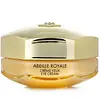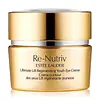What's inside
What's inside
 Key Ingredients
Key Ingredients

 Benefits
Benefits

 Concerns
Concerns

 Ingredients Side-by-side
Ingredients Side-by-side

Water
Skin ConditioningButylene Glycol
HumectantGlycerin
HumectantPropanediol
SolventSqualane
EmollientCaprylic/Capric Triglyceride
MaskingMel
EmollientAlcohol
AntimicrobialCellulose
AbsorbentArachidyl Alcohol
EmollientRoyal Jelly
Fructose
HumectantC10-18 Triglycerides
EmollientSynthetic Fluorphlogopite
Sodium Polyacrylate
AbsorbentStearalkonium Hectorite
Gel FormingBehenyl Alcohol
EmollientCI 77891
Cosmetic ColorantCetyl Alcohol
EmollientStearyl Alcohol
EmollientCaprylic/Capric/Succinic Triglyceride
EmollientAvena Sativa Kernel Extract
AbrasiveArachidyl Glucoside
EmulsifyingCaprylyl Glycol
EmollientPentylene Glycol
Skin ConditioningZingiber Zerumbet Extract
Skin ConditioningChlorphenesin
AntimicrobialPropylene Carbonate
SolventSodium Stearoyl Glutamate
CleansingTocopheryl Acetate
AntioxidantSodium Citrate
BufferingParfum
MaskingAesculus Hippocastanum Extract
AntioxidantAcrylates/C10-30 Alkyl Acrylate Crosspolymer
Emulsion StabilisingCentella Asiatica Leaf Extract
Skin ConditioningHyaluronic Acid
HumectantMalva Sylvestris Extract
AstringentSodium Hyaluronate
HumectantRosmarinus Officinalis Leaf Extract
AntimicrobialBiosaccharide Gum-2
Skin ConditioningCitric Acid
BufferingSodium Benzoate
MaskingTin Oxide
AbrasivePotassium Sorbate
PreservativeCaramel
Cosmetic ColorantSodium Hydroxide
BufferingWater, Butylene Glycol, Glycerin, Propanediol, Squalane, Caprylic/Capric Triglyceride, Mel, Alcohol, Cellulose, Arachidyl Alcohol, Royal Jelly, Fructose, C10-18 Triglycerides, Synthetic Fluorphlogopite, Sodium Polyacrylate, Stearalkonium Hectorite, Behenyl Alcohol, CI 77891, Cetyl Alcohol, Stearyl Alcohol, Caprylic/Capric/Succinic Triglyceride, Avena Sativa Kernel Extract, Arachidyl Glucoside, Caprylyl Glycol, Pentylene Glycol, Zingiber Zerumbet Extract, Chlorphenesin, Propylene Carbonate, Sodium Stearoyl Glutamate, Tocopheryl Acetate, Sodium Citrate, Parfum, Aesculus Hippocastanum Extract, Acrylates/C10-30 Alkyl Acrylate Crosspolymer, Centella Asiatica Leaf Extract, Hyaluronic Acid, Malva Sylvestris Extract, Sodium Hyaluronate, Rosmarinus Officinalis Leaf Extract, Biosaccharide Gum-2, Citric Acid, Sodium Benzoate, Tin Oxide, Potassium Sorbate, Caramel, Sodium Hydroxide
Water
Skin ConditioningCyclopentasiloxane
EmollientButylene Glycol
HumectantGlycerin
HumectantDimethicone
EmollientCaprylic/Capric/Myristic/Stearic Triglyceride
EmollientPolysilicone-11
Swertia Chirata Extract
HumectantNarcissus Tazetta Bulb Extract
AstringentLaminaria Digitata Extract
Skin ProtectingSodium Hyaluronate
HumectantAnthemis Nobilis Flower Extract
MaskingCordyceps Sinensis Extract
AntioxidantFuscoporia Obliqua Sclerotium Extract
Skin ConditioningCucumis Sativus Fruit Extract
EmollientSaccharomyces Lysate Extract
HumectantHypnea Musciformis Extract
Skin ProtectingAsparagopsis Armata Extract
Skin ProtectingAlgae Extract
EmollientPorphyridium Cruentum Extract
Skin ConditioningAscophyllum Nodosum Extract
Skin ConditioningLaminaria Ochroleuca Extract
Skin ConditioningScutellaria Baicalensis Root Extract
AstringentTocopheryl Acetate
AntioxidantEuphrasia Officinalis Extract
AntimicrobialAcetyl Hexapeptide-8
HumectantGelidiella Acerosa Extract
Skin ProtectingHelianthus Annuus Seed Extract
Skin ConditioningArtemia Extract
Skin ConditioningPyrus Malus Fruit Extract
Skin ConditioningHordeum Vulgare Extract
EmollientCetyl PEG/PPG-10/1 Dimethicone
EmulsifyingCyclohexasiloxane
EmollientHydrogenated Polyisobutene
EmollientIsononyl Isononanoate
EmollientTrehalose
HumectantSorbitol
HumectantAcetyl Glucosamine
Skin ConditioningCaprylyl Glycol
EmollientCaffeine
Skin ConditioningLauryl PCA
HumectantCaprylic/Capric Triglyceride
MaskingLauryl PEG-9 Polydimethylsiloxyethyl Dimethicone
Skin ConditioningLactis Proteinum
Skin ConditioningPolygonum Cuspidatum Root Extract
AntioxidantGold
Cosmetic ColorantHydrolyzed Wheat Protein
Skin ConditioningDecarboxy Carnosine Hcl
Skin ConditioningPropylene Glycol Dicaprate
EmollientPearl Powder
Ergothioneine
AntioxidantLinoleic Acid
CleansingGlucose
HumectantGlycine Soja Protein
EmulsifyingYeast Extract
Skin ConditioningSucrose
HumectantCitric Acid
BufferingHexylene Glycol
EmulsifyingTriethoxycaprylylsilane
Polymethylsilsesquioxane
Cellulose
AbsorbentPEG/PPG-18/18 Dimethicone
EmulsifyingAlumina
AbrasiveNylon-12
Cyclodextrin
AbsorbentSilica
AbrasiveDimethicone Crosspolymer
Emulsion StabilisingLecithin
EmollientMagnesium Sulfate
BHT
AntioxidantEthylbisiminomethylguaiacol Manganese Chloride
AntioxidantSodium Sulfite
PreservativeSodium Metabisulfite
AntioxidantDisodium EDTA
Phenoxyethanol
PreservativeSodium Benzoate
MaskingPotassium Sorbate
PreservativeMica
Cosmetic ColorantCI 77891
Cosmetic ColorantCI 77491
Cosmetic ColorantWater, Cyclopentasiloxane, Butylene Glycol, Glycerin, Dimethicone, Caprylic/Capric/Myristic/Stearic Triglyceride, Polysilicone-11, Swertia Chirata Extract, Narcissus Tazetta Bulb Extract, Laminaria Digitata Extract, Sodium Hyaluronate, Anthemis Nobilis Flower Extract, Cordyceps Sinensis Extract, Fuscoporia Obliqua Sclerotium Extract, Cucumis Sativus Fruit Extract, Saccharomyces Lysate Extract, Hypnea Musciformis Extract, Asparagopsis Armata Extract, Algae Extract, Porphyridium Cruentum Extract, Ascophyllum Nodosum Extract, Laminaria Ochroleuca Extract, Scutellaria Baicalensis Root Extract, Tocopheryl Acetate, Euphrasia Officinalis Extract, Acetyl Hexapeptide-8, Gelidiella Acerosa Extract, Helianthus Annuus Seed Extract, Artemia Extract, Pyrus Malus Fruit Extract, Hordeum Vulgare Extract, Cetyl PEG/PPG-10/1 Dimethicone, Cyclohexasiloxane, Hydrogenated Polyisobutene, Isononyl Isononanoate, Trehalose, Sorbitol, Acetyl Glucosamine, Caprylyl Glycol, Caffeine, Lauryl PCA, Caprylic/Capric Triglyceride, Lauryl PEG-9 Polydimethylsiloxyethyl Dimethicone, Lactis Proteinum, Polygonum Cuspidatum Root Extract, Gold, Hydrolyzed Wheat Protein, Decarboxy Carnosine Hcl, Propylene Glycol Dicaprate, Pearl Powder, Ergothioneine, Linoleic Acid, Glucose, Glycine Soja Protein, Yeast Extract, Sucrose, Citric Acid, Hexylene Glycol, Triethoxycaprylylsilane, Polymethylsilsesquioxane, Cellulose, PEG/PPG-18/18 Dimethicone, Alumina, Nylon-12, Cyclodextrin, Silica, Dimethicone Crosspolymer, Lecithin, Magnesium Sulfate, BHT, Ethylbisiminomethylguaiacol Manganese Chloride, Sodium Sulfite, Sodium Metabisulfite, Disodium EDTA, Phenoxyethanol, Sodium Benzoate, Potassium Sorbate, Mica, CI 77891, CI 77491
Ingredients Explained
These ingredients are found in both products.
Ingredients higher up in an ingredient list are typically present in a larger amount.
Butylene Glycol (or BG) is used within cosmetic products for a few different reasons:
Overall, Butylene Glycol is a safe and well-rounded ingredient that works well with other ingredients.
Though this ingredient works well with most skin types, some people with sensitive skin may experience a reaction such as allergic rashes, closed comedones, or itchiness.
Learn more about Butylene GlycolThis ingredient is an emollient, solvent, and texture enhancer. It is considered a skin-softener by helping the skin prevent moisture loss.
It helps thicken a product's formula and makes it easier to spread by dissolving clumping compounds.
Caprylic Triglyceride is made by combining glycerin with coconut oil, forming a clear liquid.
While there is an assumption Caprylic Triglyceride can clog pores due to it being derived from coconut oil, there is no research supporting this.
Learn more about Caprylic/Capric TriglycerideCaprylyl Glycol is a humectant and emollient, meaning it attracts and preserves moisture.
It is a common ingredient in many products, especially those designed to hydrate skin. The primary benefits are retaining moisture, skin softening, and promoting a healthy skin barrier.
Though Caprylyl Glycol is an alcohol derived from fatty acids, it is not the kind that can dry out skin.
This ingredient is also used as a preservative to extend the life of products. It has slight antimicrobial properties.
Learn more about Caprylyl GlycolCellulose is the main component of plant cell walls. It is used as an emulsifier, absorbent, and texture enhancer.
This ingredient has many functions:
Fun fact: Cellulose is the most abundant form of organic polymer on Earth.
Learn more about CelluloseCi 77891 is a white pigment from Titanium dioxide. It is naturally found in minerals such as rutile and ilmenite.
It's main function is to add a white color to cosmetics. It can also be mixed with other colors to create different shades.
Ci 77891 is commonly found in sunscreens due to its ability to block UV rays.
Learn more about CI 77891Citric Acid is an alpha hydroxy acid (AHA) naturally found in citrus fruits like oranges, lemons, and limes.
Like other AHAs, citric acid can exfoliate skin by breaking down the bonds that hold dead skin cells together. This helps reveal smoother and brighter skin underneath.
However, this exfoliating effect only happens at high concentrations (20%) which can be hard to find in cosmetic products.
Due to this, citric acid is usually included in small amounts as a pH adjuster. This helps keep products slightly more acidic and compatible with skin's natural pH.
In skincare formulas, citric acid can:
While it can provide some skin benefits, research shows lactic acid and glycolic acid are generally more effective and less irritating exfoliants.
Most citric acid used in skincare today is made by fermenting sugars (usually from molasses). This synthetic version is identical to the natural citrus form but easier to stabilize and use in formulations.
Read more about some other popular AHA's here:
Learn more about Citric AcidGlycerin is already naturally found in your skin. It helps moisturize and protect your skin.
A study from 2016 found glycerin to be more effective as a humectant than AHAs and hyaluronic acid.
As a humectant, it helps the skin stay hydrated by pulling moisture to your skin. The low molecular weight of glycerin allows it to pull moisture into the deeper layers of your skin.
Hydrated skin improves your skin barrier; Your skin barrier helps protect against irritants and bacteria.
Glycerin has also been found to have antimicrobial and antiviral properties. Due to these properties, glycerin is often used in wound and burn treatments.
In cosmetics, glycerin is usually derived from plants such as soybean or palm. However, it can also be sourced from animals, such as tallow or animal fat.
This ingredient is organic, colorless, odorless, and non-toxic.
Glycerin is the name for this ingredient in American English. British English uses Glycerol/Glycerine.
Learn more about GlycerinPotassium Sorbate is a preservative used to prevent yeast and mold in products. It is commonly found in both cosmetic and food products.
This ingredient comes from potassium salt derived from sorbic acid. Sorbic acid is a natural antibiotic and effective against fungus.
Both potassium sorbate and sorbic acid can be found in baked goods, cheeses, dried meats, dried fruit, ice cream, pickles, wine, yogurt, and more.
You'll often find this ingredient used with other preservatives.
Learn more about Potassium SorbateSodium Benzoate is a preservative. It's used in both cosmetic and food products to inhibit the growth of mold and bacteria. It is typically produced synthetically.
Both the US FDA and EU Health Committee have approved the use of sodium benzoate. In the US, levels of 0.1% (of the total product) are allowed.
Sodium benzoate works as a preservative by inhibiting the growth of bacteria inside of cells. It prevents the cell from fermenting a type of sugar using an enzyme called phosphofructokinase.
It is the salt of benzoic acid. Foods containing sodium benzoate include soda, salad dressings, condiments, fruit juices, wines, and snack foods.
Studies for using ascorbic acid and sodium benzoate in cosmetics are lacking, especially in skincare routines with multiple steps.
We always recommend speaking with a professional, such as a dermatologist, if you have any concerns.
Learn more about Sodium BenzoateSodium Hyaluronate is hyaluronic acid's salt form. It is commonly derived from the sodium salt of hyaluronic acid.
Like hyaluronic acid, it is great at holding water and acts as a humectant. This makes it a great skin hydrating ingredient.
Sodium Hyaluronate is naturally occurring in our bodies and is mostly found in eye fluid and joints.
These are some other common types of Hyaluronic Acid:
Learn more about Sodium HyaluronateTocopheryl Acetate is AKA Vitamin E. It is an antioxidant and protects your skin from free radicals. Free radicals damage the skin by breaking down collagen.
One study found using Tocopheryl Acetate with Vitamin C decreased the number of sunburned cells.
Tocopheryl Acetate is commonly found in both skincare and dietary supplements.
Learn more about Tocopheryl AcetateWater. It's the most common cosmetic ingredient of all. You'll usually see it at the top of ingredient lists, meaning that it makes up the largest part of the product.
So why is it so popular? Water most often acts as a solvent - this means that it helps dissolve other ingredients into the formulation.
You'll also recognize water as that liquid we all need to stay alive. If you see this, drink a glass of water. Stay hydrated!
Learn more about Water